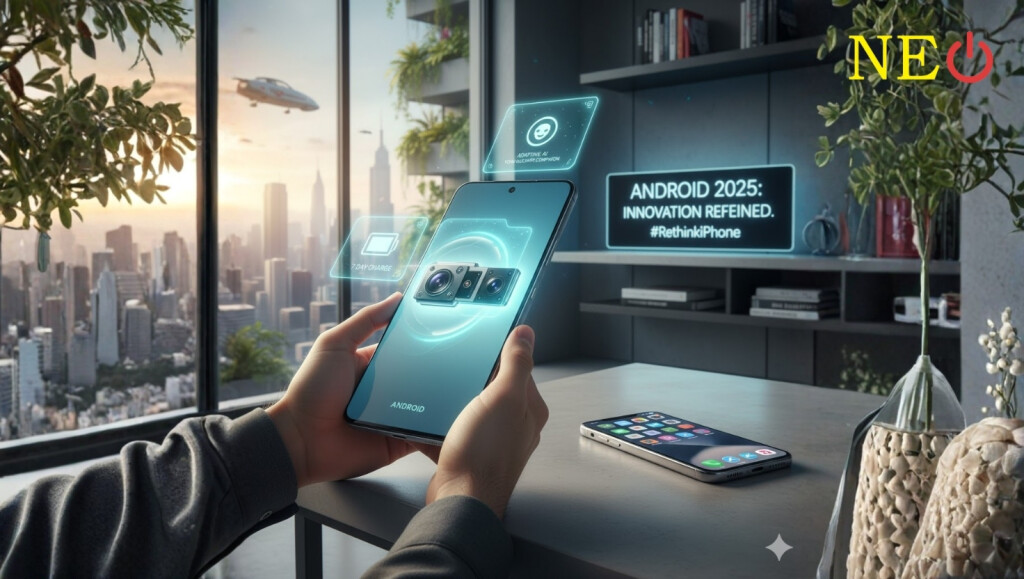Apple’s iPhone still sets the tone for slick hardware and a tightly integrated ecosystem, but 2025 has been a banner year for Android. From generational advances in on-device AI to foldables that finally justify their price, a handful of Android phones now offer experiences that challenge — and in some cases outpace — what the latest iPhones deliver. If you’re weighing an upgrade this year, here are the Android contenders that should make you pause before tapping “Buy iPhone.”
Table of contents [Show]
- 1. Samsung Galaxy S25 — refinement plus Galaxy AI
- 2. Samsung Galaxy Z Fold 6 — a foldable that’s actually practical
- 3. Google Pixel 9 — clean Android, leading computational photography and AI
- 4. OnePlus (flagships) — performance and value for power users
- 5. Mid-range marvels — flagship features without flagship prices
1. Samsung Galaxy S25 — refinement plus Galaxy AI
Samsung’s S25 series is less about headline shock and more about refining the fundamentals: brighter, more efficient displays, longer battery life, and deeper on-device AI personalization that shapes how you use the phone every day. The S25 Ultra in particular keeps Samsung at the top for camera flexibility and productivity features that blur the line between phone and pocket-sized workstation. If you value a polished camera system, long software support, and tight integration with broader Android and PC ecosystems, the S25 lineup makes a persuasive case.
2. Samsung Galaxy Z Fold 6 — a foldable that’s actually practical
Foldables have been “interesting” for a while; the Z Fold 6 is the first generation that feels truly practical for everyday use. Its slimmer, more compact dimensions, much brighter inner display, improved cooling and sustained performance mean it isn’t just a novelty — it’s a multitasking machine. For professionals and creators who want a tablet-like canvas without carrying two devices, a Fold brings genuine productivity gains (split apps, multi-window, drag-and-drop) that an iPhone can’t match in form factor.
3. Google Pixel 9 — clean Android, leading computational photography and AI
Google’s Pixel line has been the proving ground for software-led differentiation, and the Pixel 9 continues that tradition. Beyond excellent stills and computational photography, Google’s on-device AI features — from smarter assistant capabilities to photo editing and real-time transcription — show how much value software adds to modern hardware. If you want the purest Android experience, early access to new Google features, and class-leading imaging without leaning on third-party apps, the Pixel 9 deserves serious attention.
4. OnePlus (flagships) — performance and value for power users
OnePlus has sharpened its focus on high-end performance and fast charging, delivering flagship silicon, big batteries and clean software at prices that often undercut rivals. For power users who want maximum speed, aggressive charging, and a near-stock Android feel with useful extras, OnePlus flagships give you a lot of hardware for the money — making them a sensible alternative to paying Apple’s premium. If raw specs and snappy performance matter most, a OnePlus is hard to ignore.
5. Mid-range marvels — flagship features without flagship prices
One reason Android is tempting in 2025 is the trickle-down effect: features that were once flagship-only (high-refresh OLEDs, multi-camera arrays, AI-enhanced software, long software support) are now common in mid-range devices. This widening of the value curve means you can get many of the day-to-day benefits of a premium phone without the iPhone-level price tag — an important consideration when most users really care about camera quality, battery life and software longevity rather than brand prestige. See current curated lists for how many terrific Androids now live outside the ultra-premium bracket.
Why Android might beat iPhone for you in 2025
- Variety of form factors: Want a foldable, a compact flagship, or a huge-screen media device? Android offers more choices — and some, like the Z Fold 6, deliver practical, tablet-like workflows that an iPhone cannot replicate.
- Software innovation across vendors: With Samsung and Google pushing on-device AI and manufacturers offering long support windows, Android is narrowing the software parity gap while adding unique capabilities.
- Better value segmentation: From premium flagships to surprisingly capable mid-rangers, Android gives you precision control over what you pay for.
- Customization and openness: If you like to tinker — different launchers, widgets, default apps, or deeper integration with non-Apple ecosystems — Android remains the more flexible playground.
When an iPhone still makes sense
If you’re already deeply invested in Apple services (iMessage, FaceTime, Apple Watch health sync, iCloud workflows) or you want the tightest possible integration between devices, an iPhone still offers the smoothest, most cohesive experience. Apple’s hardware-software synergy and resale value are compelling reasons to stick with iOS.
Bottom line
2025’s Android ecosystem is more diverse and capable than ever. Whether you prize foldable productivity, leading computational photography, on-device AI, or sheer value, there’s an Android that can legitimately make you rethink buying an iPhone. The decision comes down to which ecosystem you want to live inside — the curated simplicity of Apple’s world, or the customizable breadth of Android’s many great phones. If you haven’t compared the latest S-series, Pixel or foldables hands-on, this year it’s worth a second look before you tap “Buy iPhone.”









